Controversy seems to be ever-present in football, and many managerial changes follow that trend – the current situation regarding Birmingham City does, too. In July of 2022, vastly experienced in the EFL Championship as a player, was named as manager of Birmingham City, with the club stuck in a rut amid ongoing off-field issues.
To put their situation into perspective, 17th is the highest finish the former Premier League side has finished since 2015-16 when they finished 10th. Last season, Eustace matched that best finish of 17th position and used that as a platform for this season, where the Blues got off to a flying start in England’s second tier, with the club sitting sixth after 11 games.
On October 9th, Birmingham City announced the departure of Eustace – a decision that shocked neutrals, although many Birmingham fans seemed to be less shocked – not because of their lack of faith in Eustace, but their lack of faith in the club’s board. Just two days prior to this sacking, Manchester United legend Wayne Rooney announced that he had resigned from his post as D.C. United head coach, with the former forward leaving the MLS after 15 months in charge. Naturally, the rumour mill began, and it was only a matter of time before the inevitable announcement of Rooney’s next managerial job at Birmingham City.
We will dive deeper into Rooney’s impact at D.C. United shortly, but in his relatively short time in the States, he left his mark, bringing a fierce attacking brand of football, and maybe that is something the higher-ups at Birmingham are a fan of – aside from the big-name status & reputation Rooney brings with him.
This report will provide a tactical analysis of Rooney’s tactics at D.C. United as we look to uncover what we should expect his Birmingham team to look like. Whether or not he is able to build on Eustace’s strong start to the season will unfold in the coming months, and this analysis will not only look at how D.C. played under Rooney but which strengths and existing key tactical elements already lie within the Blues’ ranks.
Rooney at D.C. United – an overview
Of course, D.C. United was not Rooney’s first taste of football management – you may remember his stint at Derby County, where he oversaw 85 games as boss, with a win rate of 28.2%. Again, this doesn’t look particularly impressive at face value, but under the circumstances, Rooney received plaudits from fans around the country for his efforts and some of the big results he claimed in his time there.
Of course, County were relegated in his reign, but the points 21 points deduction combined with the ongoing situations on and off the field at the club, Rooney was faced with an impossible task. We reference his time with the Rams as it holds significant relevance – from formation versatility to good pressing execution, he has clearly taken some elements of his early coaching days into the MLS.
As mentioned, Rooney was in charge of D.C. United for a total of 15 months, spanning two MSL Eastern Conference campaigns. In that time, he managed 53 games, winning 26.4% of them – this may seem like an underwhelming win rate, and while Rooney did not elevate D.C. to new heights entirely, he did see a drastic improvement in the 2023 campaign.
Further context to his improvement lies in the fact that they finished rock bottom in the Eastern Conference in his first campaign in charge but finished in the play-off places in his second season (this year). Like his time at Derby, Rooney liked to jump between various formations at D.C. United, using shapes like 4-3-1-2, 5-4-1, and 3-5-2 frequently. His most used formation this year was 4-4-2.
D.C United’s attacking output was one of the fiercest in the entire MLS, as we will see more of in the following analysis segments. Rooney’s D.C. also had had their strengths this season in defence, but some glaring weak spots shared that presence. For example, while United boasted the seventh-best record in terms of xG against (41.49), they shipped 49 goals in 34 games, leaving them with the 14th-best defensive record, so this was not their strongest area, and something Rooney will want, and need, to improve on in the Championship.
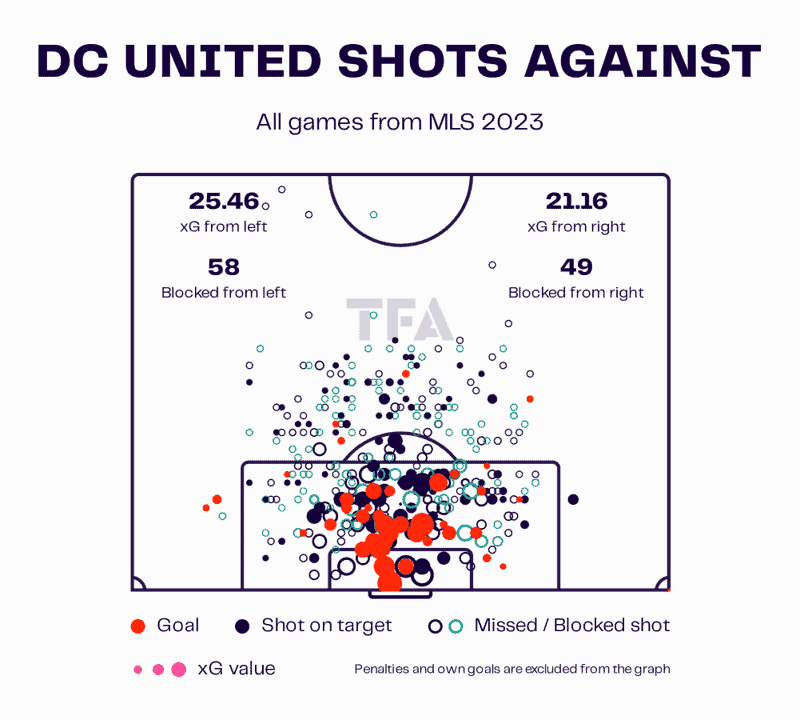
This shots against map allows a breakdown of D.C.’s defensive output this year. Like any side, they conceded most goals from central areas in the box, but when we look deeper, they allowed a lot of dangerous shots from range and even conceded six goals from outside the box. While certain aspects of their out-of-possession play held merit, United’s overall defensive record has arguably been their biggest downfall this year.
Rooney’s tactical philosophy
As we touched upon earlier, there is some overlap between Rooney’s approach at Derby and his tactics at D.C. In fact, United – implementing tactical philosophy at different clubs on different continents is a credit to Rooney’s coaching acumen. Here, we look at some of the critical tactical elements on display in his D.C. setup that you can expect to see grace the Championship this season for Birmingham City.
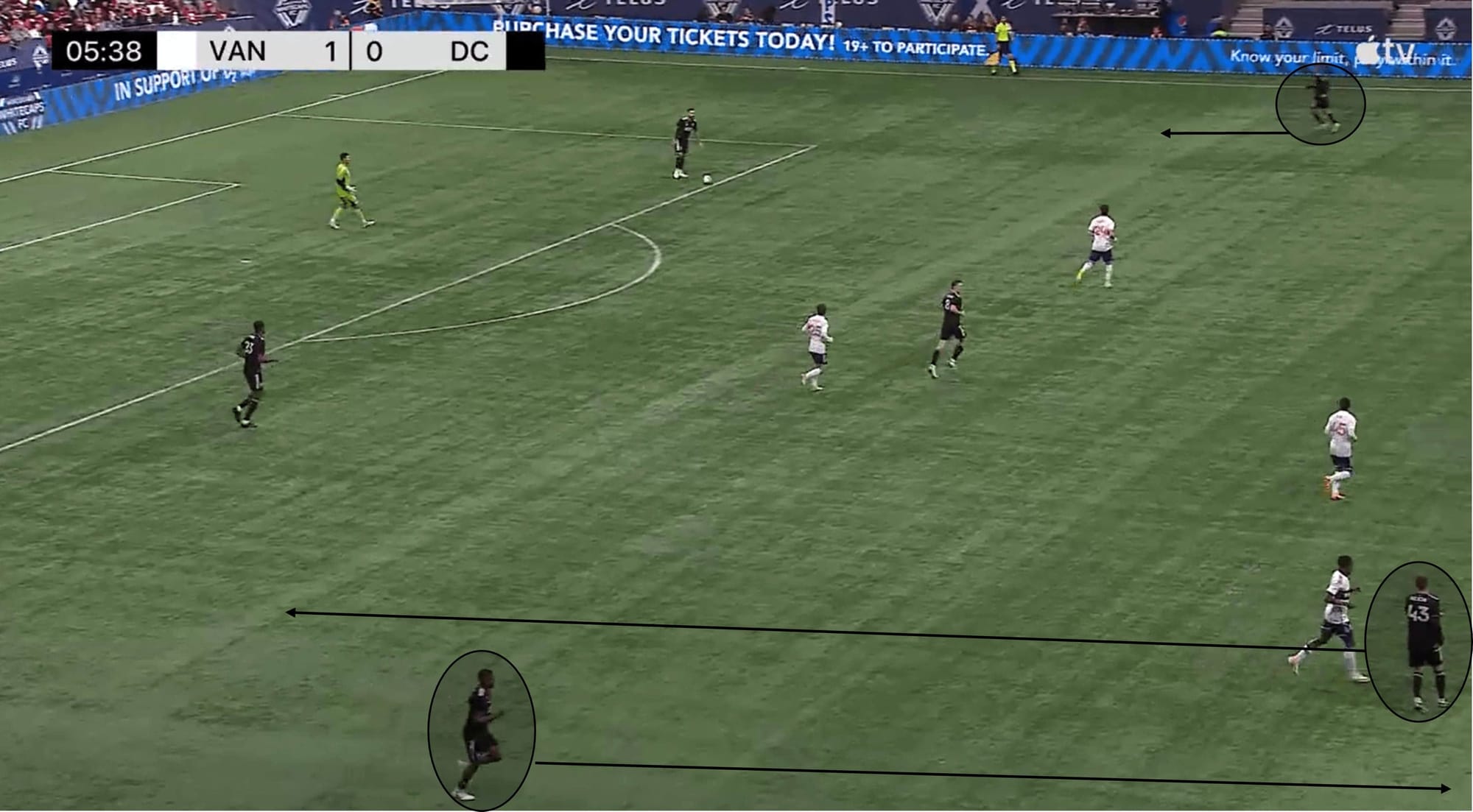
Positional fluidity is something Rooney included in his tactics at Derby, and the emphasis was increased during his time at D.C. and one particular use of this occurred at right back in the early phases of possession. As you can see above, United have comfortable possession in their own half and are shaping up to build an attack.
In what was clearly a tactical instruction from Rooney, the right-back ventured forward into the midfield third, while the deep midfielder (number 43) dropped into the right-back position. The aim here was to have a competent midfielder available in deep possession and get an attacking full-back involved higher up the pitch, able to combine with midfield teammates.
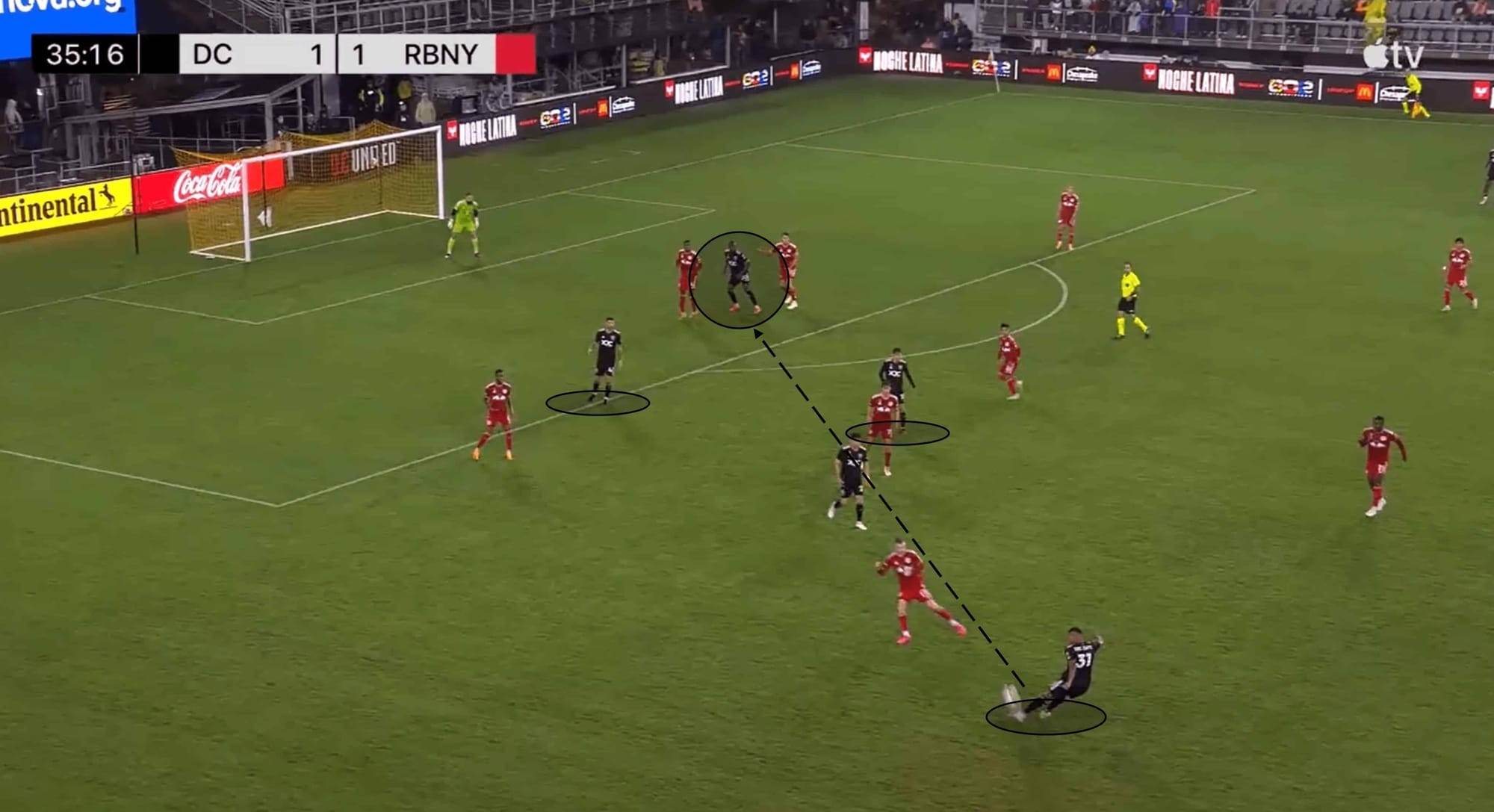
One of D.C.’s strengths and consistencies in 2023 was their use of long passing. This year, they averaged 40.7 long passes per 90 (eight highest in MLS), which highlights the consistency aspect, while their accuracy came in at ninth highest in the MLS with 58.3% – way above the league average for both metrics.
This demonstrates the clear tactical use of long passing – and who can blame them? When you have a player like Christian Benteke, who is highly effective in aerial duels and able to knock the ball down to supporting teammates, it just makes sense. This is something that Rooney could realistically look at doing with Birmingham, as the club currently have three strikers who are taller than six foot in their squad.
In fact, D.C. were aerial masters in 2023 – they averaged 35.34 aerial duels per 90 (third highest in MLS) and were the league’s most efficient, winning 55.6% – of course, these numbers occurred in all areas of the pitch, not just the final third; the ability to be effective in the air was a clear asset to Rooney.
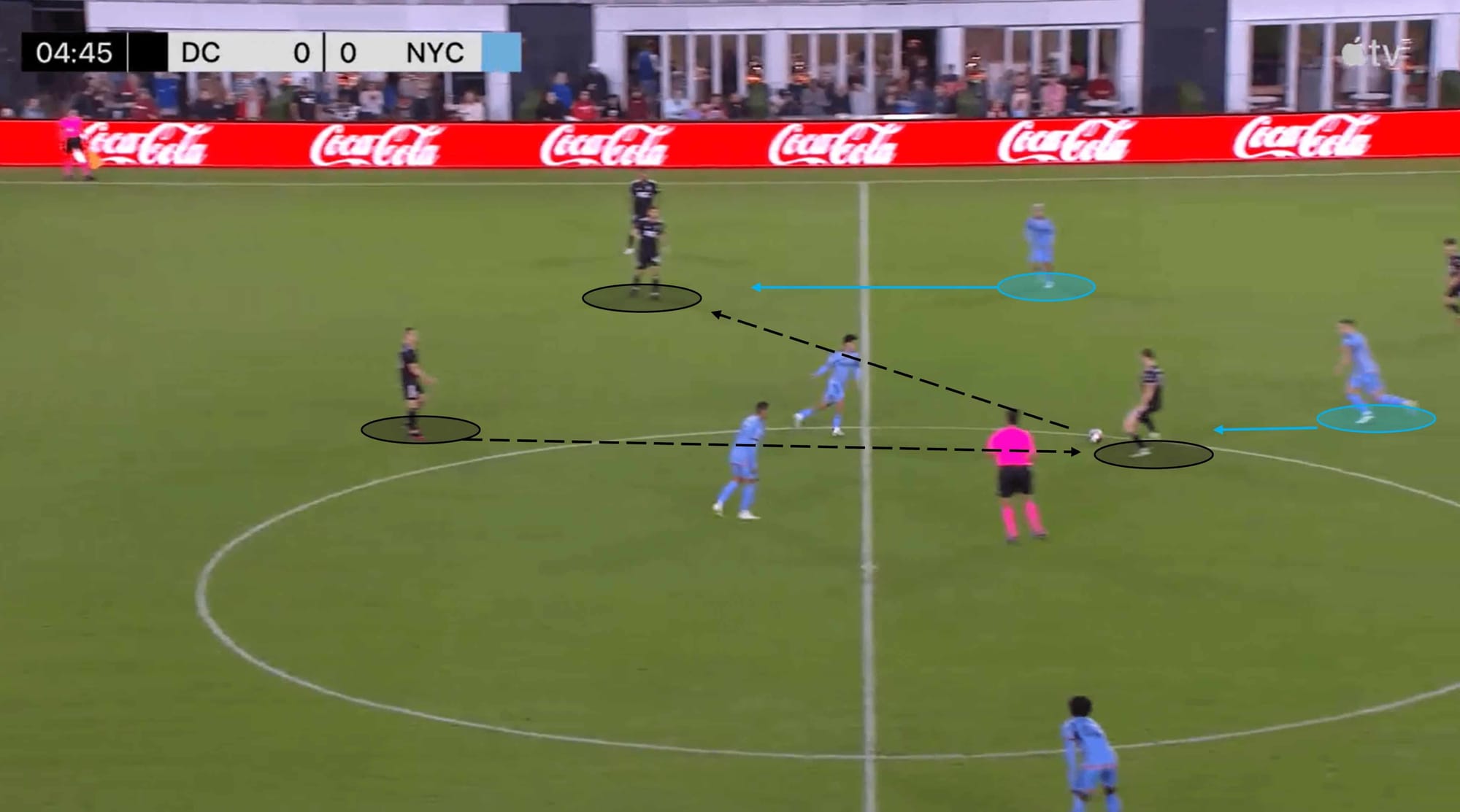
D.C. United didn’t always rely on their aerial ability to get through teams. They also showed an excellent ability to execute clever passing combinations to move either up the pitch or into a better space to start building an attack. This was often achieved by inviting the opposition press. At the same time, possession was still with the D.C. defence in order to create space to exploit – something Rooney first implemented into his tactics at Derby.
We see an example of this above: the ball being played between two opponents to reach the highlighted midfielder, who immediately bounces the pass backwards to another teammate. It is essential to recognise the movement of the two highlighted New York City players at this point – one is pressing the midfielder playing the bounce pass, and the other is pressing the player receiving the bounce pass. It was a sound theory on paper, but the quality and speed did not match the D.C. levels, as they could beat the press and exploit the space left by the rushing opponents.
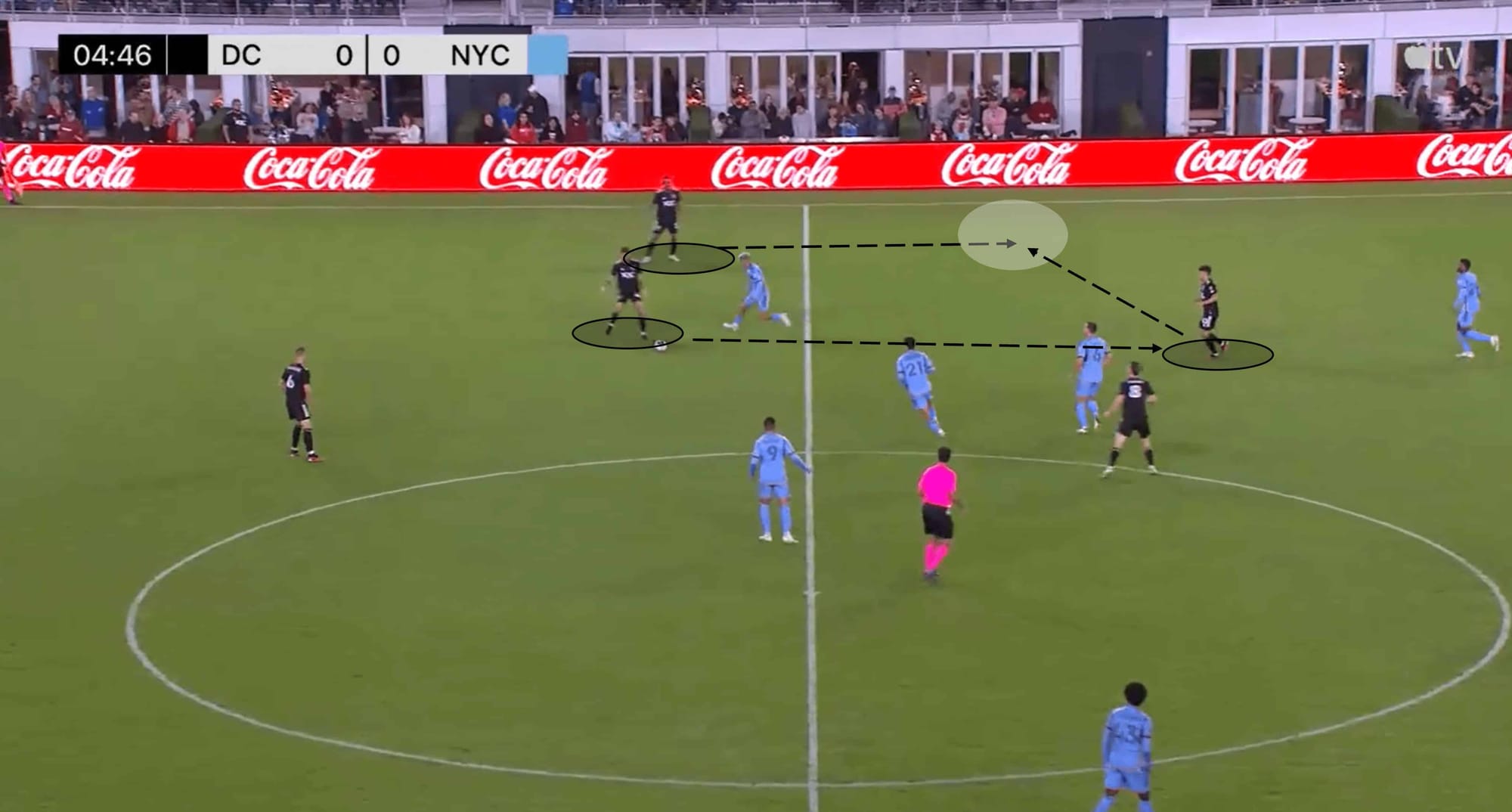
The arrival of another United midfielder in this situation adds another cog in the D.C. build-up machine, and he capitalises on the space left by the opposition press. Recognising this, his teammate at left-back becomes aware of not only the space he too has but the potential of launching an attack with the majority of the opposition midfield already beaten.
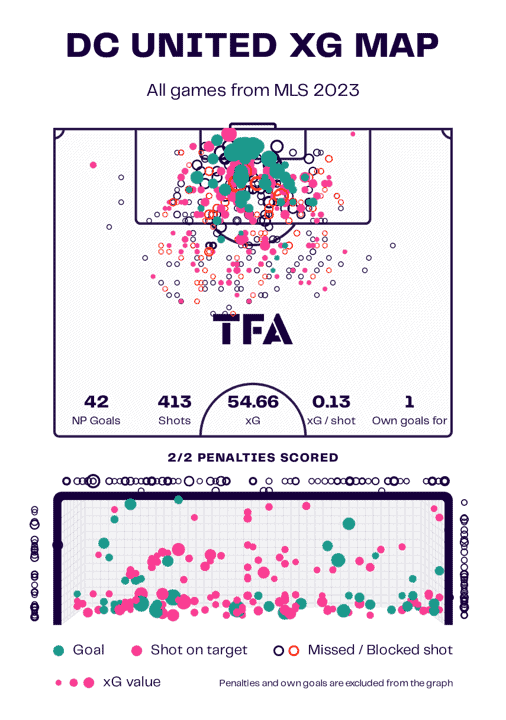
Some of D.C.’s attacking data is simply impressive. The xG map above gives you a good idea about how dangerous inside the box they were, but if we dig deeper into the data, we get a clearer sense of their ability in attack.
In 2023, they boasted the third-highest xG in the MLS (56.18), and while they underperformed that number by scoring just 45 goals, the xG record suggests that they were creating good chances consistently. We already spoke of their aerial dominance, but there is more impressive data that relates to that in a way. They had the MLS’s highest crossing accuracy (38.7%) in 2023 from the 10th highest number of crosses, yet only scored six headers, which was below the league average. Again, consistently creating chances from wide areas could be a real asset in the Championship.
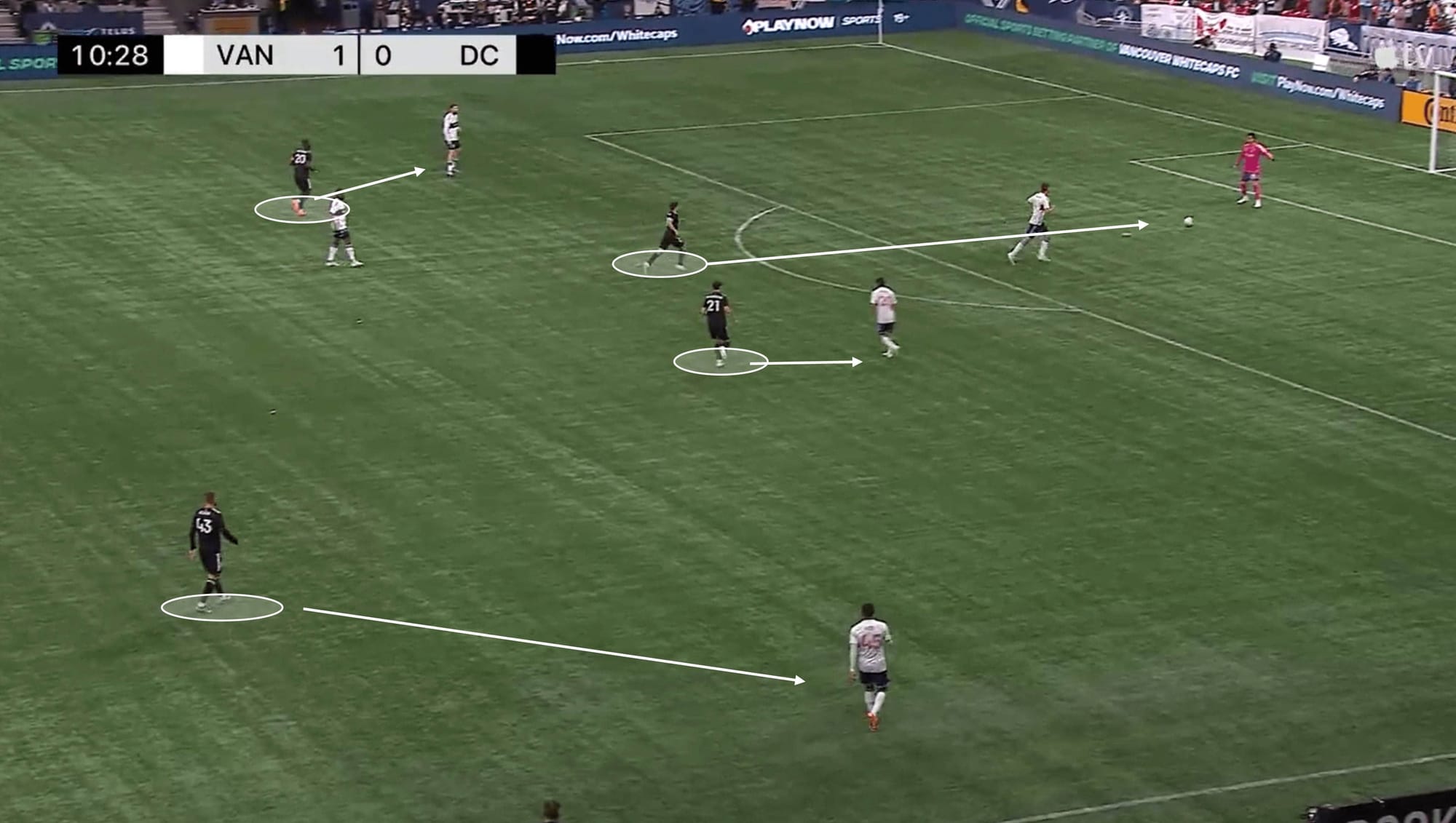
We touched on this earlier – D.C.’s defensive performance being a mixed bag of strengths and weaknesses. However, one strength they leaned on was their execution of the press. Now, they weren’t a gegenpressing machine, so they wouldn’t press at the level or intensity of, say, Liverpool do, but they have a real knack for knowing when to press – another element Rooney executed very well during his Derby days. While the example above shows his D.C. team pressing in high areas, they would not always do this, and a lot of their effective pressing occurred in the middle of the park.
In terms of numbers, Rooney’s D.C. had the fifth-highest challenge intensity in the MLS this year (challenge intensity – number of defensive actions per minute of opposition possession) and also had the sixth-lowest PPDA, indicating a high-energy approach out of possession (PPDA – passes per defensive action – the lower the number, the higher intensity the team’s press is).
Current Birmingham strengths – defensive foundations
Part of Eustace’s setup at St. Andrews had a solid defensive base – he wanted his team to be challenging to beat. That doesn’t mean his team sat back, soaked up pressure, and looked to kill teams on the break, but then they weren’t the type of team to dominate possession and break teams down with a series of passing combinations in the way we might see Liverpool or Manchester City do.
In a nutshell, Eustace managed to find a balance in the team that was able to draw the strengths out of individual players while enabling them to perform as a unit. And, as we discussed earlier, D.C. United’s defensive record was less than desirable. While this could have been down to several factors, whether it be the quality (or lack thereof) in the squad or Rooney not quite finding his niche in terms of defensive tactics, he is clearly inheriting a team who are defensively capable.
Here, we take a look at some of the defensive elements Rooney could look to deploy in his own Blues setup.
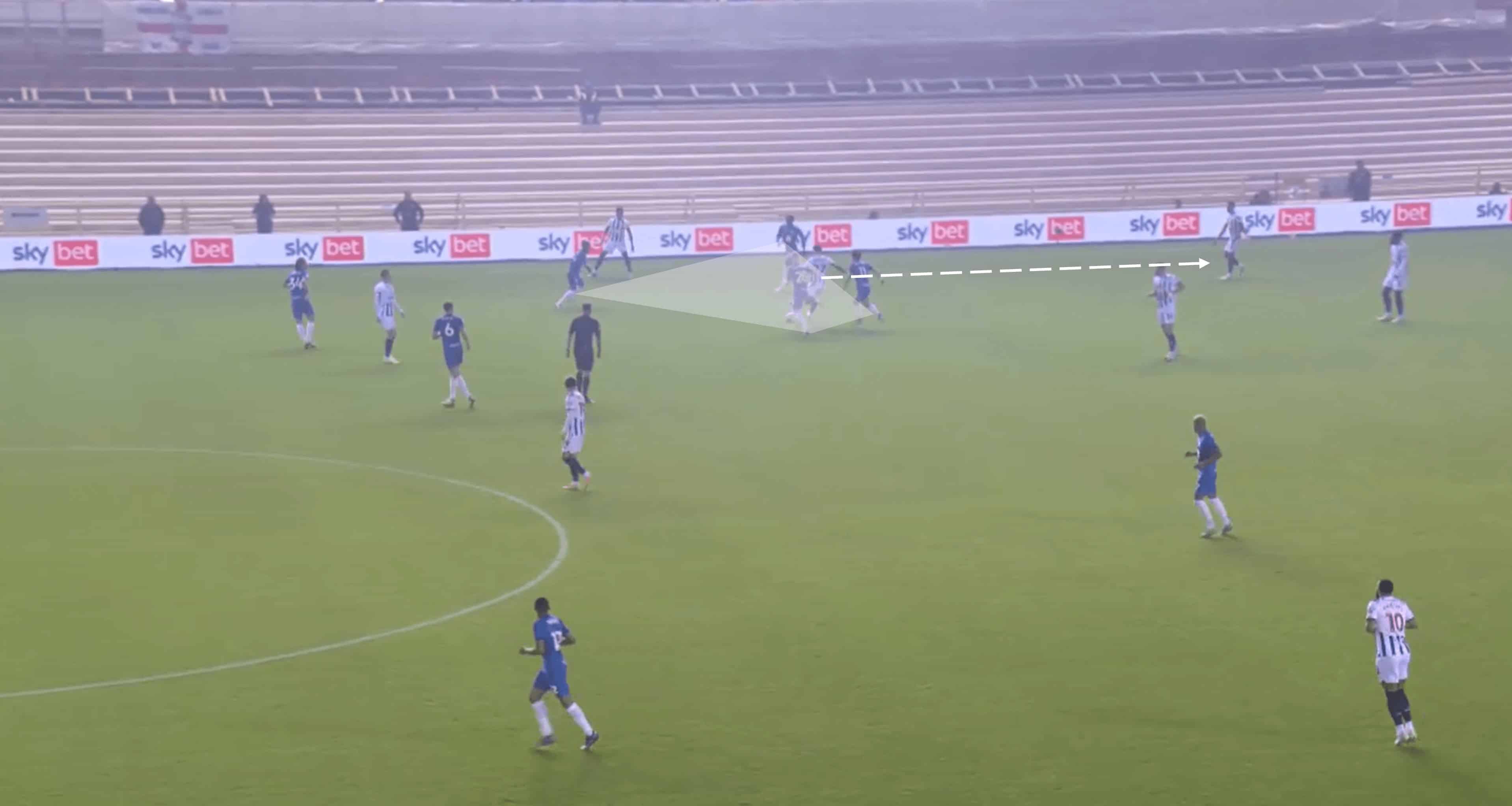
Knowing where and when to press is something Birmingham did well under Eustace, just as Rooney did with D.C. and Derby, so we are likely to see a continuation of this tactical aspect, particularly in midfield areas. On several occasions in any given game, you’ll be able to see examples of the midfield unit (and sometimes attackers and full-backs) counterpressing, forcing the opposition in a certain direction to either force a mistake or force the possession backwards, just like you can see above.
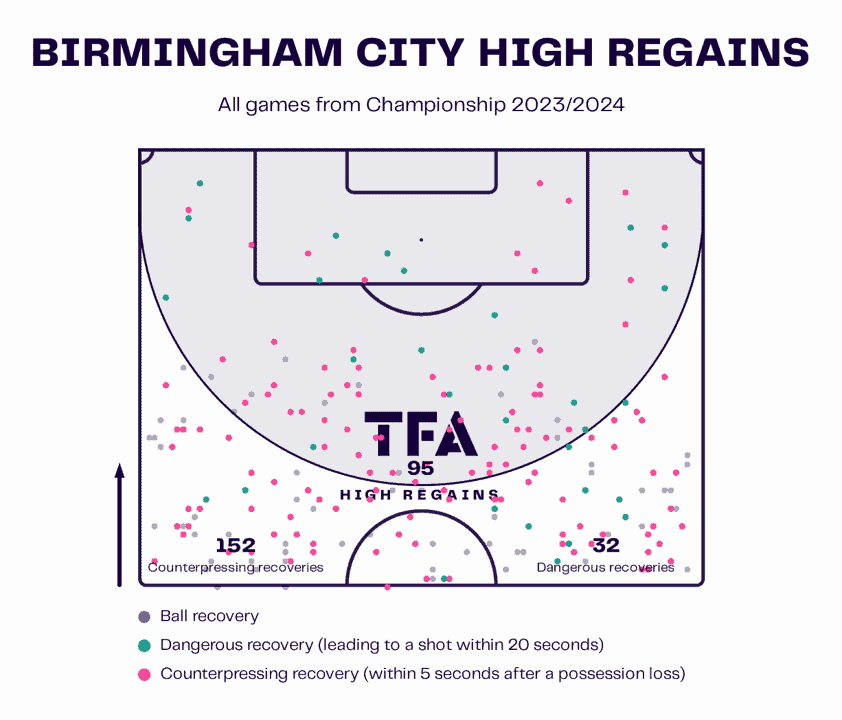
The high regains map above acts as evidence for Birmingham’s ability to apply their pressing ability, both unit and individual, in various pitch areas. With these visuals, you’ll often see that a team tends to win more balls in a particular area – on the flank just inside the final third, for example. Birmingham, however, shows the ability to react accordingly regardless of the location.
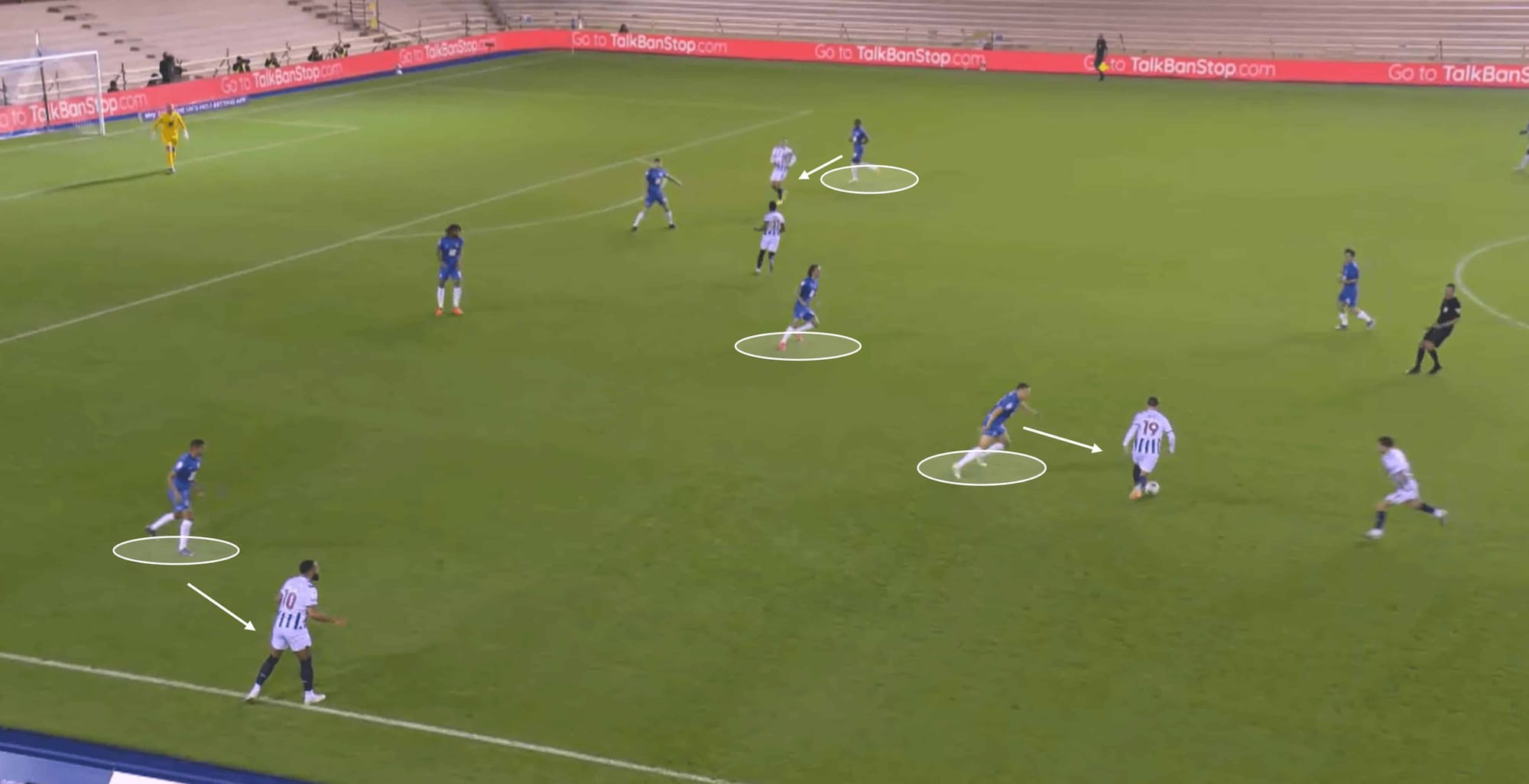
At the time of writing, Birmingham boast the Championship’s second-best defensive record, having conceded 11 goals to date. While they have general defensive organisation and tactical discipline to thank for this, they can also rely on their reaction in transition moments, as seen above. The opponents looked to launch a counterattack in transition following a turnover in possession. Birmingham’s back four was quickly in shape, with the full-backs positioning themselves according to the situation.
Additionally, the recovery of the midfield unit is often at a high level. Above, you can see an excellent example of that, from two midfielders in particular – one player pressing the ball with another player sitting deeper to block that dangerous forward pass towards the final third.
Conclusion
In a nutshell, you could say that Birmingham and Rooney are a good match due to Rooney’s ability to improve a team’s attacking output while utilising the strengths in the squad, and Birmingham’s strong defensive foundation – in theory, combining the two could be just the recipe the Blues need to have a good season. Of course, it is never quite that simple in football! Wayne Rooney has a good chance this season to prove any doubters wrong.
At the same time, Birmingham fans will hope for a continuation in form from what John Eustace built and overall managerial stability. It will undoubtedly be a big test for Rooney, and it could be argued that he already faces an uphill battle to win the fans over due to the nature of the situation. Only time will tell if Birmingham will come to regret letting Eustace go.

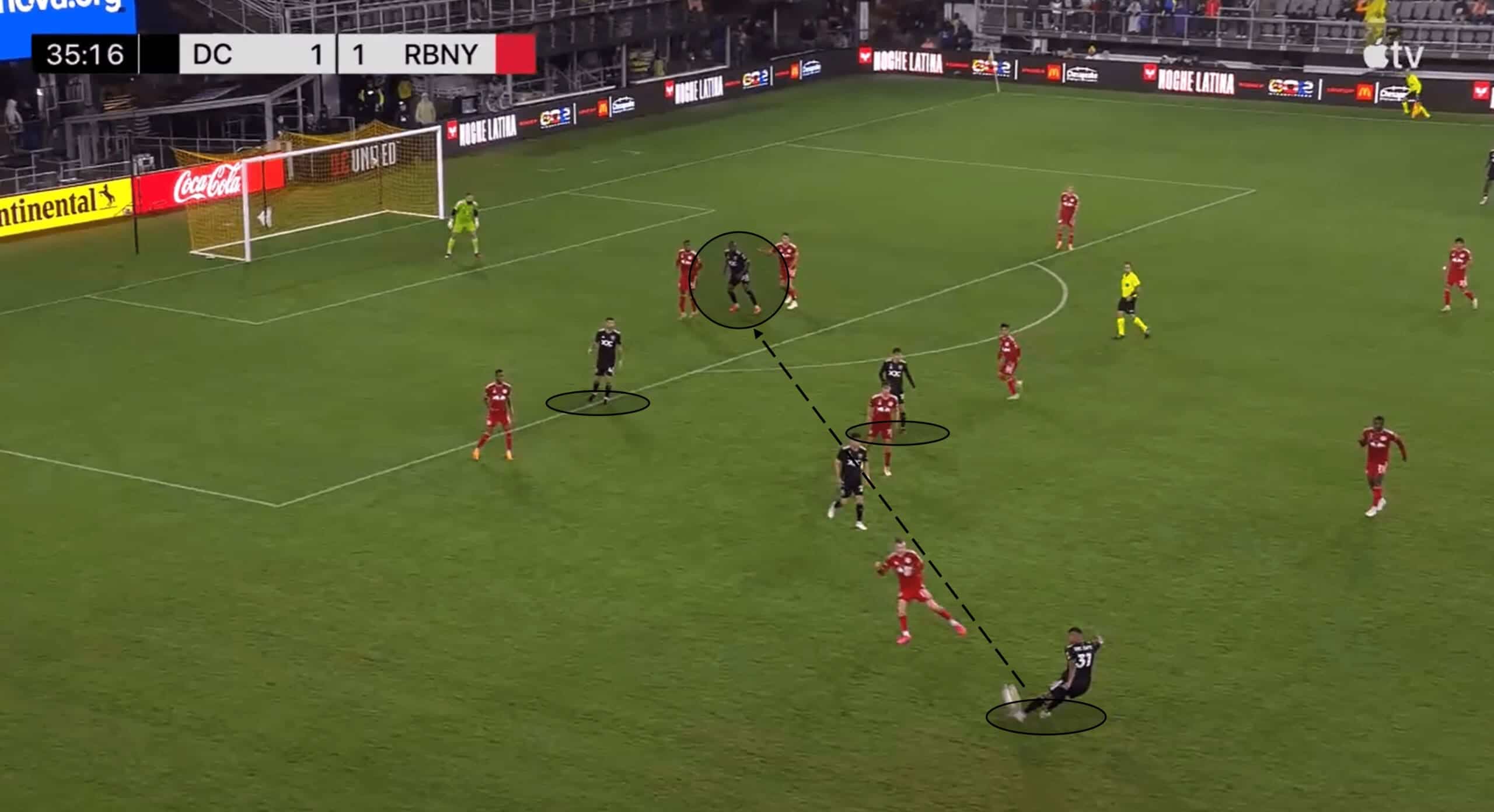




Comments